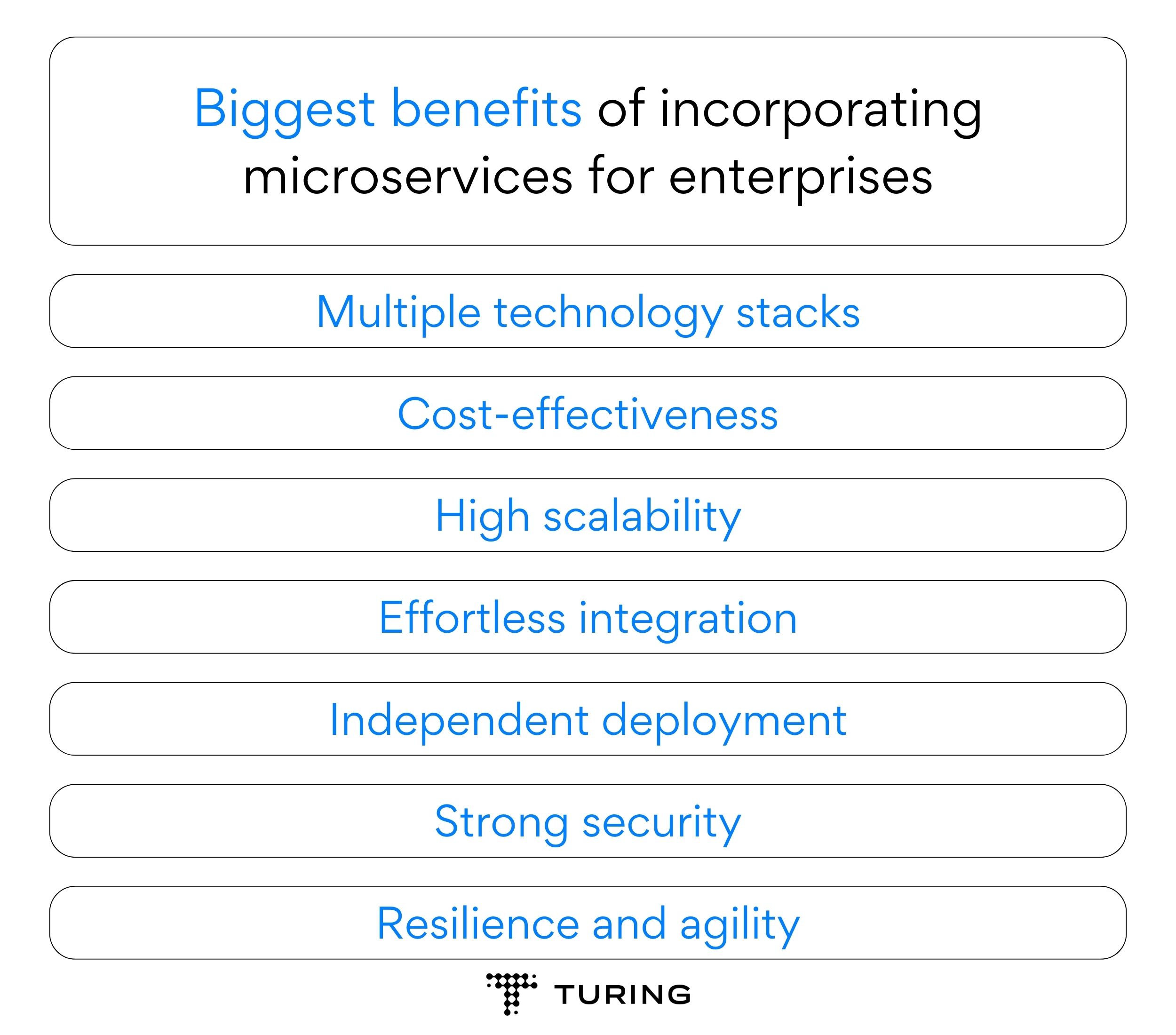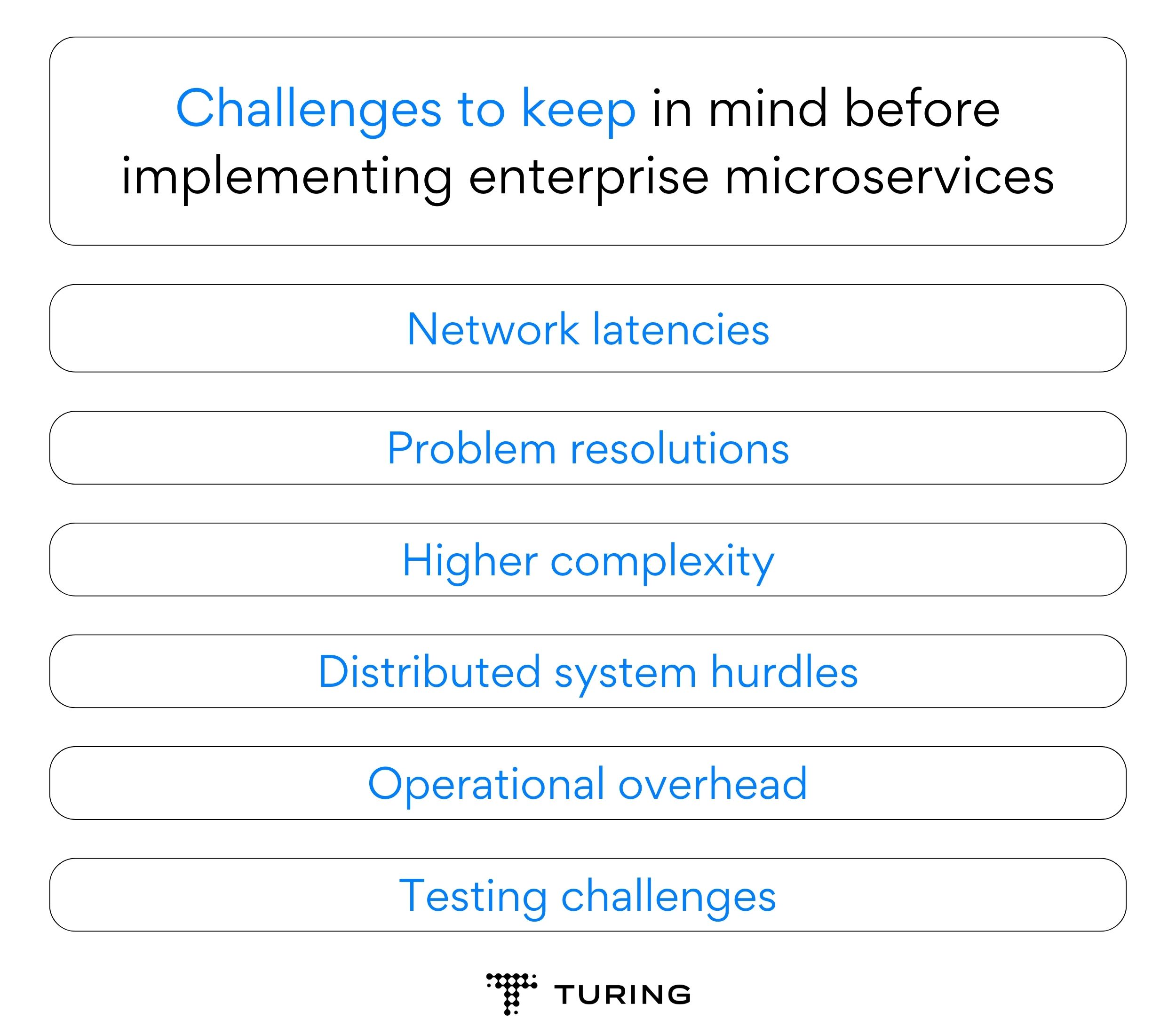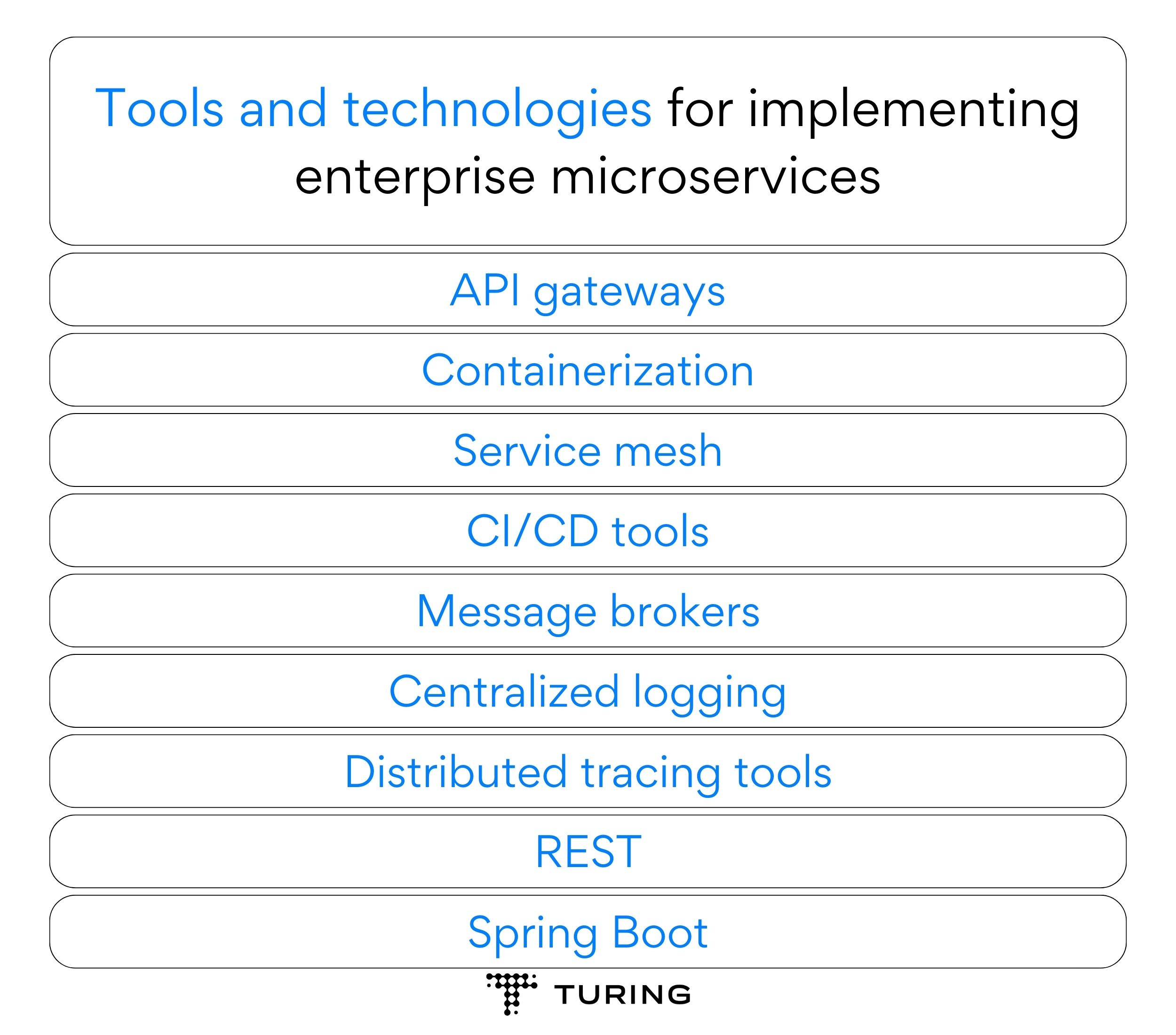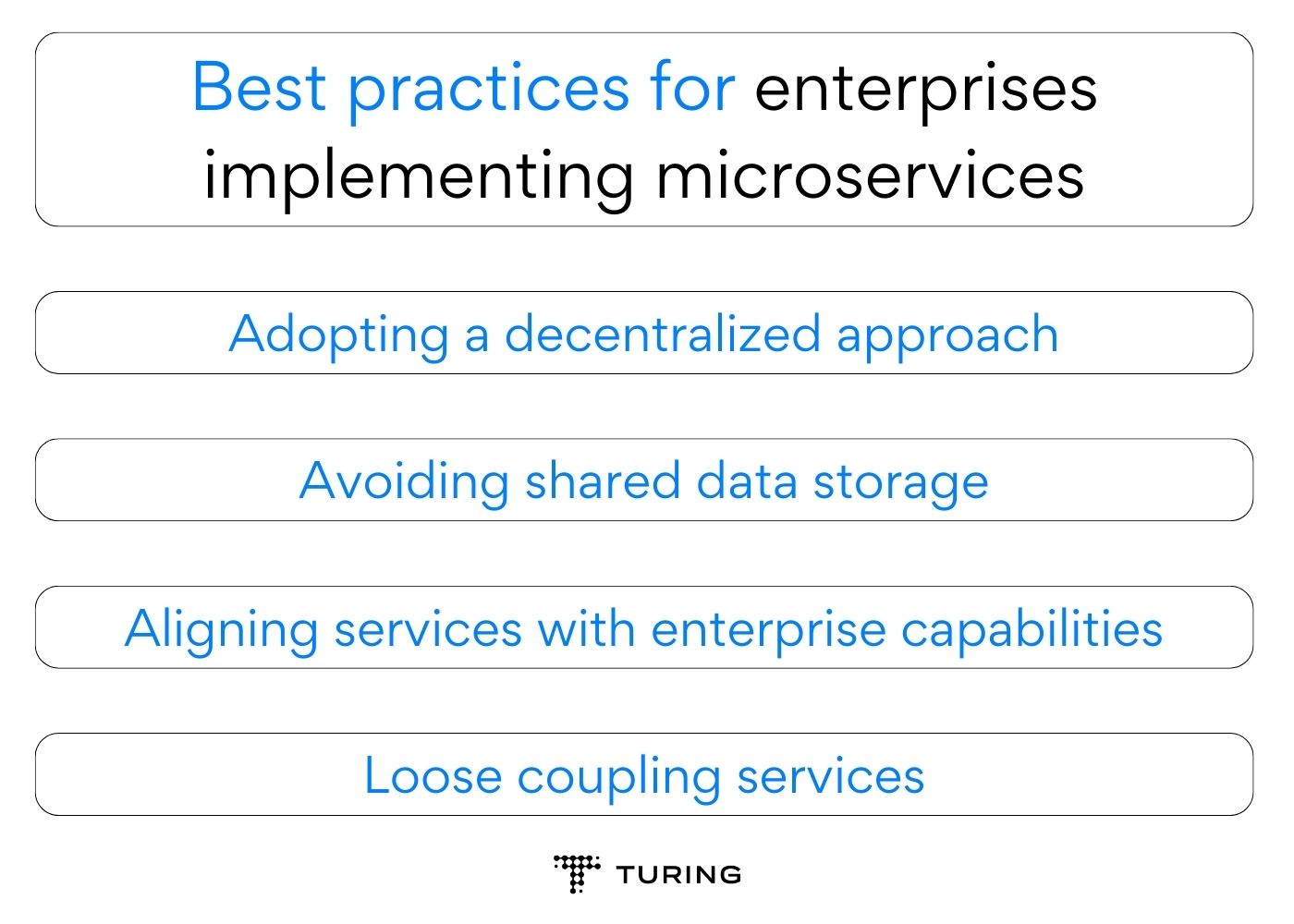Enterprise Microservices: Benefits, Implementation, and Best Practices for 2024
As enterprises continue to navigate the complexities of today’s tech landscape, three things are of utmost importance: how they address their employees’ needs, their customers’ demands, and their industry changes. As such, enterprise microservices are designed to help with each of the three areas.
So, what are microservices? Why are they becoming more popular, and more importantly, why should you implement them? This blog aims to answer these questions and explain microservices business benefits, implementation methods, and best practices.
Let’s dive in!
What are enterprise microservices?
Microservices, aka microservices architecture, is an architectural style that structures applications as suites of independent and small services that can interact with one another over a specified network.
When employing the enterprise microservices approach, companies break down their services into smaller, loosely-coupled business services. These microservices can work together, and companies can deploy them autonomously and independently. This simplifies the designing, developing, and delivering of complex software systems as companies can maintain individual services without impacting the entire system, ensuring maximum flexibility and scalability.
Talking about the structure, each microservice has its separate codebase and data management model, managed by a small development team. These developers typically write and maintain the microservice, which communicates with another microservice over network protocols through the appropriate APIs.
Enterprise microservices are created around business capabilities. An enterprise can independently deploy its microservices through fully-automated deployment procedures, which expedites software development. For instance, if a company has a shopping app for both mobile and web, its microservices can include catalogs, the in-app shopping cart, the ordering section, discount content, etc.
What is the driving force behind enterprise microservices?
One of the major microservices business benefits is their ability to push organizations toward better development and application deployment. Since each microservice is developed and maintained by an autonomous team, the microservices approach is potentially the most scalable option for software development, leading to its massive popularity today.
Using microservices, businesses can develop applications faster, scale them better, experience tech innovation, and accelerate the time-to-market for new in-app features. Here’s a broader look into the driving force behind microservices:
-
Microservices are promising for enterprises
- Given the independent nature of microservices, they can easily improve developer flexibility and productivity, while also enhancing application resiliency. Hence, when implemented well, enterprise microservices can potentially boost business responsiveness and innovation by:
-
- Facilitating incremental and rapid app changes
- Speeding application delivery
- Optimizing production costs
- Ensuring resiliency when scaling
- Allowing developers to use the best tools and technologies
Moreover, an online survey conducted by TechRepublic Premium has also shown that companies adopting microservices are already experiencing some of their advantages. As per the survey, organizations that have implemented microservices have seen faster service deployments (69%), higher flexibility to adapt to changing business conditions (61%), and a better ability to rapidly scale new application features (56%).
-
The critical microservices business benefits
More often than not, developers and business authorities disagree when it comes to the software application’s framework. While the development teams highlight the importance of architectural framework and elegance, business heads deny their real-world implications and prefer allocating resources elsewhere.
However, the enterprise microservices architecture is one that both sides seem to favor equally. The microservices approach enables companies to build applications from various independent services that update on their own. This helps to simplify replacing or adding application features which is often the case in an evolving business environment.
Here are some of the biggest benefits of incorporating microservices for enterprises:

Biggest benefits of incorporating microservices for enterprises
- Multiple technology stacks: Conventional application architectures often include relational databases that support the entire app. Such an architecture is written on a codebase requiring common data models and technology stacks. Most developers find this traditional approach restricting as they are bound to use the technologies suitable for the architecture. If there are better applications for certain components, developers cannot use them.
One of the biggest advantages of microservices is how they free developers from this restriction. Developers can choose the approaches and technologies they deem best for creating enterprise microservices, from containers, Kubernetes, and dockers, to serverless models, API gateways, and tools like Consul, Oracle Helidon, REST, etc. - Cost-effectiveness: As mentioned earlier, every service in microservices is independent, as they have their own database and data model. Hence, developers can make any necessary tweaks or upgrades over time without affecting other components, making microservices extremely cost-effective for enterprises in an ever-changing business landscape.
- High scalability: Scalability is inherent in enterprise microservices, thanks to their modular structure. When traditional monolithic applications are scaled, their lack of modularity causes negative effects on the overall application structure.
The microservice architecture frees organizations from this by allowing them to split the application into microcomponents that can be scaled independently, based on unique business objectives. Hence, enterprises that aim to expand and grow in the future will benefit the most from microservices. - Effortless integration: Given how microservices are built on well-defined APIs, developers can easily integrate them with third-party services through modern integration techniques.
APIs form the communication layer between enterprise microservices and third-party services. Following standard protocols like GraphQL or RESTful principles, a microservice exposes the required endpoints to enable seamless data exchange with external systems, making them fairly simple to integrate for development teams. Some of the most popular third-party services you can integrate with microservices are:- Payment gateways like Square, PayPal, and Stripe
- Cloud services like Google Cloud Platform, Microsoft Azure, or AWS (Amazon Web Services)
- Authentication and authorization providers like OAuth or SSO (single sign-on) providers
- Email and communication services like Mailgun or SendGrid
- Social media platforms, through social media APIs
- Monitoring and analytics tools like Mixpanel or Google Analytics
- Messaging services like WhatsApp API or Twilio
- CRM and marketing tools
- Geolocation services like Mapbox or Google Maps
- Independent deployment: As mentioned earlier, microservices are independent in nature. This breakdown of a single service into smaller components expedites and simplifies deployment, as developers don’t need to change the entire application codebase to add a feature to it.
Moreover, enterprise microservices offer high flexibility to the organization adopting them, as different teams can work on the same application, each team utilizing its specialized knowledge to work on a relevant component. Ultimately, this combination of independent components and multiple teams decreases the deployment time and ensures the best possible technology stacks are being used. - Strong security: Since microservices communicate through APIs (application programming interfaces), they automatically prioritize security. Even when microservices are integrated with third-party services like payment gateways and cloud services, tight security is maintained. This is because a microservice communicates the native application’s data securely, both externally and internally, avoiding any security risk whatsoever.
Hence, enterprises, especially those dealing with crucial customer and business data, must implement microservices to ensure maximum data integrity and security. - Elimination of departmental silos: Businesses often face departmental silos that stem from dividing departments into individual units. Not only does this hamper business efficiency, but also obstructs customer experience improvements.
Thankfully, enterprise microservices have proven to be an effective counter to departmental silos. Here’s how:
- Decentralization: The microservices architecture entails separate teams developing and maintaining each service. As such, dependencies on specific teams are reduced, enabling each department to operate seamlessly and focus on its specialized area.
- Standardized APIs: Since microservices communicate through well-defined APIs. these APIs act as integration layers. These standardized APIs allow different teams to interpret each other’s needs and interact without requiring an in-depth understanding of their internal workings.
- Clear service boundaries: Microservices are designed as per specific business capabilities. This defines clear service boundaries, encouraging teams to stick to their domain expertise and avoid conflicts or duplication of their efforts, which are common in monolithic application architectures.
- Cross-functionality: Enterprise microservices require companies to divide teams based on specific business abilities, instead of departmental lines. As a result, cross-functional teams are formed that work together towards common organizational goals and foster a shared sense of ownership, breaking down silos.
- Continuous integration and deployment (CI/CD): The modular nature of microservices enables teams to ensure rapid development and deployment through CI/CD practices, leading to better communication, reduced response times between teams, and frequent updates.
- Resilience and agility: Apart from flexibility, agility and resilience are also some of the major microservices business benefits. Since each service is independently developed, managed, and deployed, any service failure doesn’t necessarily impact the rest of the application negatively. Plus, this independent nature also enables faster development timelines as teams remain agile by developing and testing single services. Hence, implementing microservices is an excellent way to ensure both application agility and resiliency during development.
- Multiple technology stacks: Conventional application architectures often include relational databases that support the entire app. Such an architecture is written on a codebase requiring common data models and technology stacks. Most developers find this traditional approach restricting as they are bound to use the technologies suitable for the architecture. If there are better applications for certain components, developers cannot use them.
Challenges to keep in mind before implementing enterprise microservices

Challenges to keep in mind before implementing enterprise microservices
While microservices offer an array of benefits for better enterprise operations, there are certain drawbacks to keep in mind before implementing them. These include:
-
Network latencies
Given that microservices operate on the multiple-service model approach, they depend on strong interservice communications. Hence, if the chain of services is too long, microservices can often experience network congestion or latencies, which can delay the overall development cycle.
-
Problem resolutions
As microservices include several smaller services working in tandem, there are vast amounts of data logging involved. Sometimes, this large data logging can lead to data inconsistency and difficulties in monitoring and solving issues. -
Higher complexity
As lucrative as enterprise microservices are, they are highly complex too. Compared to traditional monolithic architectures, microservices involve multiple services communicating with each other and several development teams working on each service. As a result, both the development and maintenance of the application become more complex, and your organization may need to hire additional expertise and invest in more resources to get the job done. -
Distributed system hurdles
As mentioned above, network latencies are a common challenge companies face when adopting microservices. Latencies occur due to the distributed nature of such microservices, which may also cause complexities in terms of handling failures and data consistencies. However, organizations can tackle these by implementing robust mechanisms for load balancing, inter-service communication, and service discovery. -
Operational overhead
With enterprise microservices, companies may sometimes face an increased operational overhead as they need to manage, deploy, and scale multiple services. Plus, teams must be allotted, who can monitor each service independently. If an enterprise comprises DevOps teams, they may need more effort and expertise to tackle these tasks efficiently to ensure the timely development of the application. -
Testing challenges
With several services running independently in a microservice, monitoring, testing, logging, and debugging can become more challenging. Your organization will need to implement robust, well-defined logging practices and monitoring tools to understand system behaviors effectively and make appropriate changes seamlessly.
While there are certain limitations to be aware of, microservices business benefits often outweigh them. Hence, an increasing number of companies are adopting microservices to better navigate today’s technology landscape. If you’re aiming to do the same, then let’s take a look at how you can properly implement microservices in your enterprise.
Implementing an enterprise microservices architecture
Implementing microservices in an enterprise involves two major facets: the implementation tools and technologies, and the deployment methods. Depending on your business goals and application structure, you can choose which tools and deployment paths suit your objectives best. To help you with that, here are the key tools and deployment methods to consider:
-
Tools and technologies

Tools and technologies for implementing enterprise microservices
- API gateways: While microservices communicate directly with one another, you will need to implement API gateways as your microservice-based application grows. You can use API management platforms like Apigee, Kong, AWS API Gateway, MuleSoft Anypoint Platform, and IBM API Connect to use API gateways for seamless app functioning. Alternatively, if your team uses Kubernetes or containers to implement the microservices architecture, service mesh tools like Consul, Linkerd, or Istio can be used for API gateways.
- Containerization: One of the most popular containerization tools, Docker, allows developers to package a microservice and its dependencies into containers, ensuring consistency across environments. Enterprises also implement Kubernetes, a highly-used container orchestration platform, to automate the deployment, management, and scaling of microservice-based containerized applications.
- Service mesh: Apart from implementing API gateways, a service mesh like Istio, Consul, or Linkerd, can help organizations perform seamless traffic management, load balancing, service observability, and service discovery. These help simplify the management of communication between enterprise microservices.
- CI/CD tools: As mentioned earlier, CI/CD is one of the best ways to eliminate departmental silos when working with microservices. Companies often use CI/CD tools like GitLab CI/CD, Jenkins, or CircleCI, for automating the process of creating, testing, and deploying a microservice, ensuring reliable and faster releases.
- Message brokers: For implementing microservices, enterprises must also use message brokers like RabbitMQ or Apache Kafka to enable event-driven architectures and communication between microservices. These message brokers help teams to decouple services and facilitate asynchronous communication.
- Centralized logging: Tools like Graylog or ELK Stack (Elasticsearch, Logstash, and Kibana) are also important when adopting microservices. These tools help aggregate and analyze logs from different microservices, allowing teams to conduct seamless debugging and auditing.
- Distributed tracing tools: Tools like Zipkin and Jaeger are also integral to microservices implementation as they facilitate distributed tracing, which helps development teams understand how requests flow through various microservices. Using distributed tracing tools, teams can simplify the process of changing configurations whenever needed, without redeploying a service.
- REST: REST (representational state transfer) is another popular tool that helps enterprise microservices communicate directly through HTTP. Teams often use REST to create RESTful APIs, where responses and requests are handled via standard formats like JSON, HTML, and XML.
- Spring Boot: Spring Boot is a Java framework that provides collaborating components to help companies build large-scale systems using simple architectures. Given how teams can easily integrate Spring Boot with other frameworks, as its control is inverted, it’s commonly used by enterprises implementing microservices in their applications.
-
Deploying enterprise microservices
Once you finalize the tools required to implement microservices as per your enterprise goals, you can choose an appropriate deployment method. Some of the best deployment paths for microservices include the following:
- Serverless deployment: AWS Lambda is one of the best technologies for serverless deployment. Development teams can package various microservices into a ZIP file and release it on AWS Lambda. This approach automates the process of running instances and handling requests, making the deployment seamless.
AWS Lambda can be implemented in four ways:- Implementing automatically to respond to events generated by an AWS service, such as Kinesis, DynamoDB, Simple Email Service, or S3
- Using a web service request to invoke the AWS Lambda function directly
- Periodically following a cron-like schedule
- Managing HTTP requests from the application’s clients via AWS API GatewayToday, AWS Lambda is one of the best possible ways to deploy enterprise microservices. Lambda supports Python, Java, and Node.js services, and provides request-based pricing. This pricing method is a major advantage as it lets organizations pay for the actions their services perform, empowering their teams to focus on application development instead of tackling IT infrastructure concerns.
- Server instance per container: This approach involves deploying a microservice’s instances on its containers. Each container has a port namespace and dedicated root filesystem, enabling teams to limit the container’s CPU resources and memory. Teams often use Docker and Solaris Zones to implement containers, but many also use Marathon and Kubernetes to manage container placements to align them with the required resources for a host.
- Service instance per VM (Virtual Machine): The service instance per virtual machine approach involves teams packaging every service as a virtual machine image, like an Amazon EC2 AMI. A real-world example of implementing this approach is Netflix, where they use the service instance per VM pattern to provide their video streaming services. Netlfix’s teams’ package services as EC2 AMIs through Animator and release the services as EC2 instances.
Currently, there are various tools to create VMs, like Jenkins, Packer.io., and Animator. This service instance per VM approach is an excellent way for teams to leverage mature cloud infrastructure. Leveraging this allows teams to avoid worrying about exhausting CPU memory and other resources as services run independently, making deployment more reliable and straightforward.
- Serverless deployment: AWS Lambda is one of the best technologies for serverless deployment. Development teams can package various microservices into a ZIP file and release it on AWS Lambda. This approach automates the process of running instances and handling requests, making the deployment seamless.
Best practices for enterprises implementing microservices

Best practices for enterprises implementing microservices
Implementing enterprise microservices is quite lucrative, but only when it’s done right. Since this is a relatively new concept and is still complex, here are a few proven best practices you can follow to adopt microservices in the best possible way.
- Adopting a decentralized approach: Since the entire framework of microservices is based on a decentralized model, implementing it will work best when your organization adopts a decentralized approach to building an application. This way, teams with specialized skills can work on services best suited to their abilities, without sharing data structure and codes, and ensure application success.
- Avoiding shared data storage: Building on the previous point, storing data independently for each microservice is key to avoid control issues that may occur during later stages of development.
In a traditional monolithic application, a service directly calls data from the database to use the same data from another service. However, this can cause several issues in an enterprise architecture. While making changes later, teams can face difficulties and lose the very flexibility microservices offer. Hence, avoiding shared data storage is one of the cornerstones of effective microservices implementation. - Aligning services with enterprise capabilities: One of the best ways to adopt enterprise microservices is to make the best of your existing and functional systems. You must align microservices with your organizational capabilities, identifying which services would go best with a particular business ability. For example, a logistics company may need shipment tracking, delivery management, and transportation management, and align its microservices with these areas to get the best results.
- Loose coupling services: Lastly, when your company implements microservices, it must stick to the core principle: loosely-coupled services. The microservices approach is designed to offer loosely coupled services that can operate and be managed independently.
If you couple one service tightly with another, any change in one will make it compulsory to fix other services too. Hence, it’s best to package services loosely to ensure maximum agility and resiliency when creating microservice-based applications.
The takeaway
Enterprise microservices have become an attractive architectural approach for most modern businesses. Adopting microservices will enable your organization to maintain maximum scalability, agility, resiliency, and technology diversity when creating software applications. Moreover, the microservices approach also encourages cross-functional collaboration, allowing teams to adopt continuous integration and deployment practices to seamlessly scale applications and ensure their optimal performance.
Turing’s enterprise application development services are designed to cater to unique business needs, including microservices adoption. Our extensive experience with creating enterprise microservices solutions for fast-scaling startups and Fortune 500 companies has put us at the forefront of tech innovation, with over 100 companies trusting Turing to achieve business transformation.
Book a call with us today to leverage our cutting-edge solutions and adopt tailored microservices, hassle-free.
Tell us the skills you need and we'll find the best developer for you in days, not weeks.












